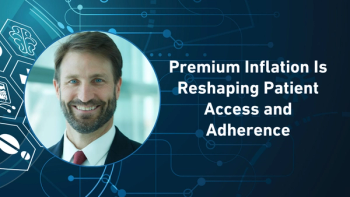
- Pharmaceutical Commerce - September 2019
- Volume 14
- Issue 3
A conversation with Jim Lang, Eversana
Building up a service offering from the research lab to the patient’s home
Not quite a year ago, an assemblage of pharma service providers came into being as Eversana. Funded by two private equity firms with a background in healthcare—Water Street Healthcare Partners and JLL Partners, there were six acquisitions at the time: Dohmen Life Science Services (itself a prior rollup of contract logistics, rare disease patient support and specialty pharmacy), The Access Group, Alliance Life Sciences, Health Strategies Group, Triplefin, and Patient Experience Project. Shortly after, it added Seeker Health and field sales units acquired from Mission Pharmacal. Together as EVERSANA, the organization delivers a fully-integrated service ranging from clinical trial support to consulting on drug pricing, to supporting the patient journey from diagnosis to cure. It operates globally, and has over 2,000 employees.
Jim Lang was brought on as CEO of the as-yet-unnamed organization in mid-2017; former CEO of Decision Resources Group, he has a long history in healthcare consulting and leadership. Pharmaceutical Commerce sat down with Mr Lang to find out where Eversana is going; here’s what he had to say.
1. First of all, let’s talk about the unusual assemblage of companies that make up Eversana, which could be called a logistics provider, a patient-support provider or even a healthcare agency. What is Eversana trying to be?
We’re trying to be a catalyst for change to fill a gap in the life science sector. When we were forming Eversana, we recognized that both the CRO (clinical research organizations) and CMO (contract manufacturing organizations) industries were being well delivered. Yet, our end customer is in desperate need to pivot to patient-centered, value-based care. Therapies are getting far more targeted to narrower populations and we didn’t see the CMO and CRO centric players being able to make this shift quickly. And, unfortunately the commercial services sector remains highly fragmented.
Eversana offers a fully integrated commercial services platform designed to solve patient support, distribution, field force, compliance and marketing challenges in a very integrated way. We keep patients, and the value the life science industry creates for those patients, at the center of all solutions we create and execute. To build quickly, we bought only the top leaders. Our services span everything from clinical trial recruitment to long-term therapy adherence which ensures that we are patient-centered because we are with the patient every step of the way.
2. Eversana’s self-description reads that it is “the leading independent provider of global services to the life science industry.” The question is, independent of what? Another aspect of this question is what the advantages are of being owned by private equity companies, whose goal is usually to build up an asset and then sell it.
We’re independent, meaning we’re not tied to wholesalers; we’re not tied to CROs. That’s important because we believe a wholesaler is inevitably in conflict with the manufacturer. Their income depends on the spreads they take in the distribution channel. The business model inherently makes them at odds.
With the CRO industry, it’s slightly different. Both the CRO industry and our commercial services are helping the life science company be successful, but managing a clinical trial is a very different business than providing innovative patient-centered solutions. We’re independent of the biases that come from a scaled CRO model, allowing us to be much more creative in the kinds of solutions we invent.
We also gain independence by being owned by private equity players known for building market leaders. It affords us the liberty of making significant investments on behalf of our clients and their patients. We’ve probably invested more than $50 million annually in the last two years in the kind of technology transformation that’s needed for the next generation of patient-centered, value-based services. That’s really difficult to do in the public markets, but really easy to facilitate with private equity owners who share in your vision. Water Street Healthcare Partners’ business model is built on a vision for better healthcare, which is why they’ve chosen to commit 100% to that sector, and JLL Partners has about half its portfolio in healthcare. Each has proven their ability to build market leaders that continue to flourish under subsequent ownership.
3. With business units like the Patient Experience Project or Seeker Health, it’s clear that Eversana is taking to heart today’s emphasis on patient focus. Most service providers to the pharma industry make the same claim, as do many pharma companies themselves. What differentiates Eversana’s focus from all the others?
We agree—patient centricity has been a buzz word in the industry for a long time, but the reality is that the industrial complex of life sciences was really built up to serve healthcare providers and payers. Those constituents will always remain important, but our mission is to deeply understand the patient journey, especially the challenges patients are having. That’s a very complex problem when you’re looking at rare diseases and specialty products, which is the center of our focus.
Instead of allowing the businesses we’ve acquired to operate separately, we have an integrated team approach to developing solutions that are patient centric—whether it’s finding patients for clinical trials, staging them for a product launch, or creating innovative ways to avoid abandonment and keep patients on therapy. We’ve created a commercial services platform that goes the full life cycle of the product journey. That’s the same journey many patients are forced to walk alone, but Eversana is walking it with them by adding value in the pharmaceutical life cycle.
4. Several Eversana business units provide guidance on drug pricing and reimbursement policy—a topic that is being intensively argued over these days. Is there a particular approach Eversana takes to this topic? What should pharma companies be doing these days to anticipate value-based contracting?
While there has been the rare bad actor in the life science industry, when you look at the collective impact the industry has had on the health of humankind, it’s been massive. Diseases have been eradicated. Our quality of life has been vastly improved. Hope has been given to many who had none. It’s interesting when you consider the debate on pricing: What amounts to less than 15% of our healthcare budget has now become 100% of our attention.
As the industry develops more complex and innovative therapies, even cures for smaller populations, it needs to do a better job communicating value and impact. Some of these products save society millions of dollars a year. How do you make those arguments more consumable for both the intellectual world of regulatory and payers, as well as the common place world of newspaper headlines?
Eversana is a leader in creating value-based contracts and developing methods to measure outcomes. We’ve taken a unique approach in which we’re aligning our incentives with those same value-based contracts so that we’re a true partner with our life science partners in having their patients achieve incredible success and having a fair, value-based transaction with payers.
5. Linked to drug pricing and reimbursement is the industry practices on channel management, which Eversana controls directly through its logistics services. How does better channel management translate into better business performance by a pharma manufacturer?
When you look at the industry as a whole, manufacturers have taken a traditional approach to logistics. We have the rare privilege of stepping back and taking a broader view to see where things are headed. We can step outside that traditional box, anticipate needs, and thoughtfully invest in areas like cell and gene therapy. We’ve invested in a broad spectrum of channel services to the life science sector, helping manage costs and mitigate risk.
For example, we’ve expanded our cold chain storage and made strategic alliances in chain of custody and compliance logistics to support advancements in regenerative medicine. We’ve added the responsiveness necessary to get life-saving products into patients’ hands at a moment’s notice. In the end, it’s not just about speed, but accuracy. It’s one thing to move a common medication — it’s very different moving a life-saving biologic or transplant companion drug. We take pride in being the lowest cost on the former, and the most effective on the latter.
6. With a few of your recent announcements (e.g., the appointment of Bhaskar Sambasivan, formerly of IT services firm Cognizant), Eversana is signaling its intention to provide digital health services. What’s your vision about how this will play out in the industry, especially since Eversana has also expanded in “analog” services like field sales and clinical nurse educators?
Thank you for paying close attention to our business moves! Certainly our recent moves are key to the future DNA at Eversana. To work from your metaphor, we see healthcare as a mix of analog and digital services. Complex therapies may need to be delivered at home with a nurse, while at the same time that nurse needs to capture patient outcomes on his/her iPad to ensure we’re seeing the clinical improvement. The industry is going to be required more and more to demonstrate its value.
We are seeing a massive shift to tech-enablement both in our services and the digital therapeutics that we support with our commercial services. Many services that were done purely with people are now accomplished with tech-enabled solutions, and AI is now playing a big role and is a big investment area for us. Bhaskar looks at all processes and people solutions with that lens and will help us accelerate that shift, which was already well underway.
It’s about providing the right kind of information to all healthcare constituents quickly and accurately, whether it’s patients, payers, or healthcare providers. It’s now a two-way communication, and the more technology allows information to be shared and linked, the more powerful the solutions can become to get patients on the right therapies quickly, and keep patients on therapy to drive amazing outcomes.
7. Mr. Lang, you’ve been involved in multiple large organizations across a variety of industries. What’s the attraction of managing a firm involved in services to the pharma industry? How do you connect personally with healthcare?
I’ve been blessed to be in this industry nearly 30 years now and I’ve always found it highly interesting because of the opportunity to improve how our healthcare systems work. But my interest grew 1,000 fold starting in January of 2016. That’s when my then-14-year-old daughter developed a severe migraine. She has since been diagnosed with New Daily Persistent Headache (NDPH) which is a ravaging rare condition in which she has an almost bed-ridden level migraine 24 hours a day, 7 days a week, 365 days. It’s unrelenting and after 3.5 years dealing with it, and hundreds of treatments and tests, she remains undeterred to live as great a life as possible. I don’t believe I could have the strength.
It’s really allowed me to see the healthcare world through the lens of a patient challenged with a disease that has limited answers. I have seen firsthand how longitudinal information on a patient is not managed and kept. I’ve seen firsthand how physicians are challenged to deal with really small slices of information to make judgments about what to do, and how even as people like myself in the caregiving community become consumer centric in terms of trying to bring forward theories and ideas on what might be practical, how the industry really isn’t prepared to hear that. It’s been quite frustrating from many different dimensions.
I’m confident the life science industry will eventually find a cause and treatment for her. It has been three-and-a-half years now, but it has certainly upped my interest on behalf of the millions of patients with these rare diseases, cancers and other challenges. I view it as a moral imperative to improve this industry for people like my daughter and the many generations to come.
Articles in this issue
over 6 years ago
2019 Cold Chain Provider Directoryover 6 years ago
Pharma cold chain: greener and more digitizedover 6 years ago
Big Data in pharma cold chain logisticsover 6 years ago
PDSA helps bring along a DSCSA governance organizationNewsletter
Stay ahead in the life sciences industry with Pharmaceutical Commerce, the latest news, trends, and strategies in drug distribution, commercialization, and market access.




